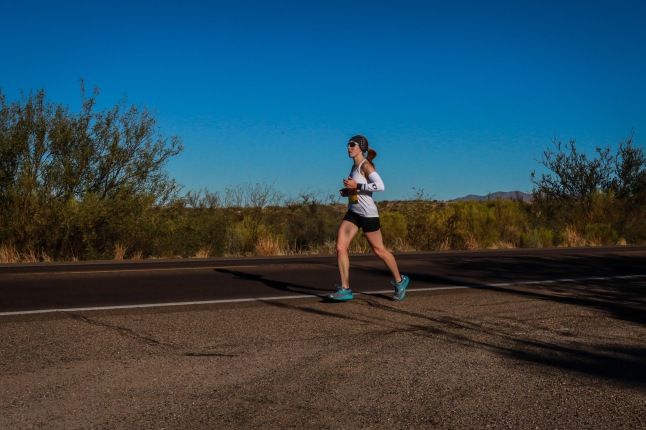
I ran my first marathon in June of 2014. I thought then that I would run that marathon, qualify for Boston (fingers crossed), run Boston and be done with marathoning. 12 marathons later, I find myself still running, still reaching for bigger goals, still trying to discover my potential in the sport and amazed at what my body has let me accomplish thus far.
Marathon number 12 led me to the desert region of dusty Arizona. Why Tucson? Well, I’ll tell ya….
Why Tucson
In July of 2017, I ran the Desert News Marathon. It was the first marathon where I achieved my race time goal after two significant marathon fails where I hit the wall on the course and came in well over my desired time goal.
The Desert News Marathon not only encouraged me to keep on working at my goal to get faster, but restored my faith in my ability to still improve in the sport despite injury and advancing age.
I shopped around, mainly using a website called FindMyMarathon.com, to find a Fall or Winter marathon that I could get excited about. Most Fall marathons were too soon after Desert News to run safely. Finding a winter marathon can be tricky because of weather across the United States that time of year, but Tucson had ideal temps and pretty good stats/reviews to back it up.
The real deciding factor was learning that my long-time friend, Annie Ballard, who lived in Phoenix near Tucson, had signed up for the marathon and was planning on running it. (We have run two previous marathons together; she inspires me to no end!) Annie’s proximity to Tucson made marathon logistics that much easier.
The prospect of running another marathon with her sealed the deal!
The Training
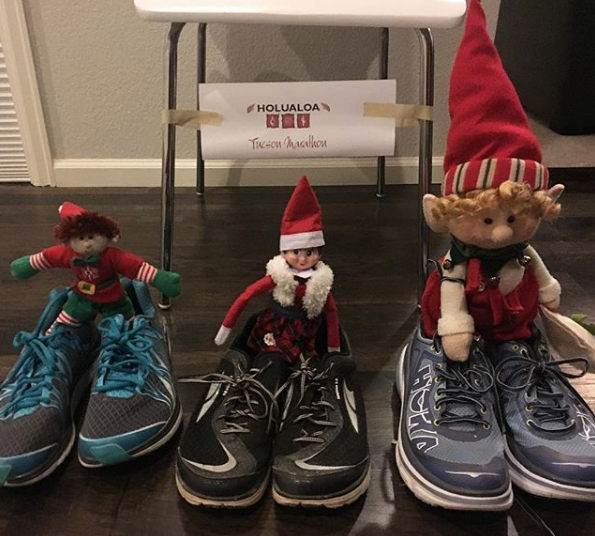
A little elf send-off the night before I left for Tucson.
I have found over the past few years, since I started running marathons, that a race on the horizon helps hone my goals and keep me testing my current abilities. However, this training cycle was a rough one for me. I found myself lacking drive and floundering with what goals were attainable. I also found myself questioning whether or not I wanted to continue pursuing the sport on a competitive level. I dreaded more runs than I looked forward to and couldn’t find that inner fire to push me past the pain/discomfort to the results I desired. Or, in this case, didn’t desire enough. My mental game was off. But, once I started, I just couldn’t bring myself to throw in the towel. I had to see the training through.
Body-wise, I had a pretty smooth training cycle. Other than some occasional lower back pain, I was injury free. Considering that I threw in three 20-milers and a few 60+ mile weeks, my body demonstrated that it has, in fact, made some significant progress in adapting to longer and more intense running distances.
Sidenote: I switched from my Altra Torins to the Brook Ghost 10s for this training cycle to try something new and they did the job just fine. Honestly, Altras are still my favorite, but I have to acknowledge that I didn’t have to use KT Tape during this training cycle and my body seemed better supported by the Brooks shoes than the Altras. My Altras still feel more comfortable to me, but perhaps their zero-drop feature doesn’t work as well for my body and injury history?? Hard to say….
Carb-loading and Tapering
The weeks leading up to my race, I was still logging 50-60 miles and not feeling like I was really tapering. So, I abandoned my training plan the last week and reduced my miles, significantly, to try and give my body time to repair and prepare for Tucson (as seen in the Strava graphic below):

The week leading up to the marathon you are both reducing your miles and increasing your carbohydrates (carb-loading) which can leave you feeling really weighed down. Tapering and carb-loading are my least favorite parts of marathon training (other than the hour before race start). That said, over the years how I carb-load has evolved to a system that I feel works for me.
The three days before my marathon are my carb-loading days. I rely heavily on the MyFitnessPal app to hit my goal of 300 grams of carbs per day without overdoing it on the calorie end.
I avoid heavy pastas and breads and rely more on the carbs found in vegetables, rice and fruit while making sure I get lean protein as well. (If my stomach could handle sweet potatoes, they would be on the list, but I have a food sensitivity to them.)
I also started using a product called CarboPro after my aforementioned friend, Annie, recommended it. CarboPro is great because you still benefit from complex carbohydrates, but without the feeling of heaviness they often pack. (It was a great recovery tool too. I packed a Ziplock bag of it in my gear bag and added it to my water right after I finished the race to help boost my muscle recovery).
Anxiety, Anxiety, Anxiety
The week, days and hours leading up to my marathon departure date were anxiety-filled days. Despite all the hours and weeks of training, I wasn’t sure I would make it to Tucson.
I was a bundle of nerves whenever I contemplated running the marathon. Literally, the night before I was still “do I stay, or do I go; do I stay or do I go….” Again, I wanted to see my training to its end; to finish what I started, but I was NOT excited about testing myself. My body may have been primed and ready to go, but my mind wasn’t. So much of marathon success is mental. The fact that my love for the sport was waning wasn’t helping me have the mental grit that I knew I would need out on the course.
My 2016 New York Marathon fail and 2017 Boston Marathon fail were still to fresh in my mind. After experiencing what it is like to hit the wall during a marathon—after all those weeks of training—I also was struggling under the weight of possible failure yet again.
Honestly, I couldn’t exactly pinpoint what was causing all my anxiety. At some crucial point, I remembered the quote “what would you do if you could not fail” and when I applied that to my upcoming marathon it became clear that I was, in fact, very afraid of failing. Most of why I didn’t want to go was wrapped up in that.
Once I realized that; once I realized it wasn’t just that I was going to miss my family, or that I would get behind in my work responsibilities or neglect other demands of a busy time of year–examples of the excuses I was leaning on during my debates with myself—once I realized I really was just afraid of failure, I knew I had to go.
Fear of failure was not a worthy reason for me to pull out; to not attempt. I hadn’t put in 18 weeks of training to not go and test myself and my progress.
The Expo
After reuniting with Annie at the Phoenix airport, we headed to the marathon expo in Tucson. It was about a 2-hour drive so we had time to catch up and enjoy the beautiful Arizona scenery. The expo was held at the host hotel where we were staying the night, The Hilton El Conquistador. Considering the smaller size of the race, I was really impressed with the quality and organization of the expo. They had some great vendors and Whole Foods had a table where you could grab a paper bag and make your own trail mix— very clever!
The Hilton Conquistador is a very impressive resort. Settled in a rugged mountain range, it was decked with cacti, palm trees and exquisitely manicured lawns by refreshing pools. Inside, they had a life-size gingerbread house—the real deal; all made with food goods—that was big enough to walk inside! That was magical!
Race Evening
Our evening was spent preparing for the race and visiting/catching up with one another. With a 4 am alarm on the horizon, our goal was to be in bed around 8pm.
I have adopted Annie’s pre-marathon meal of white rice and some protein. Nothing exciting, but it does the job!! We ate and went to bed!
Race Morning
Neither of us slept very well despite the comfort of our room, but readied ourselves for our 5:15am bus rendezvous. Poor Annie wasn’t feeling well and was nursing a hip and hamstring injury but was still going to go out and give the course her best. Her grit, determination and resilience were inspiring in the face of the looming 3-hour physical and mental battle we were about to enter.
The Race Start
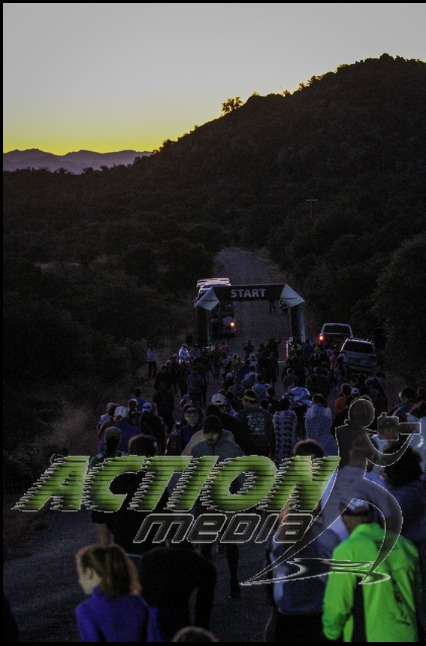
An image of race start provided by Action Media.
I must say that of my 11 marathons before Tucson, not many stacked up to the organization of this race.
We met the buses outside the hotel at 5:15 am. We were welcomed by the site of not school buses, but coach buses equipped with bathrooms! The bus ride to the race start was comfortable AND, drumroll, we were allowed to stay on the buses as long as we wanted at race start. This was great because it meant we could stay warm on the buses and conserve the energy normally spent trying to stay warm during the hour before race start.
High-elevation-influenced temperatures before sunrise are no joke. (The temperature at race start was a chilly 28 degrees–not bad once you start running and descend, but when you are just sitting, pretty brutal.)
They also had plenty of porta-potties so we never had to wait in line–another unheard of component to this race compared to others. They also provided food, water and gatorade at the top of the course for those that needed it.
We chatted on the bus for the hour before start and prepared for the race. About eight minutes before race start, we decided it was time to leave the comfort of the heated buses and head for the the starting line.
These moments, right before race start, standing at the starting line, getting ready to embark on a 26.2 mile journey into the unknown, are both exhilarating and terrifying. I can remember each of my 12 race starts vividly. This race start was framed by a beautiful sunrise and rugged mountain peaks.
Strategy dictated that we position ourselves toward the front to avoid getting clogged with runners of slower speeds. (The beginning of the race is always somewhat congested until the pack spreads out.) If you get caught behind pace at the beginning, it can adversely affect your speed goals for that first mile. We analyzed the field, counted the number of women with us and estimated how many would remain a few miles in.
I kept my sweatshirt on and my fleece blanket wrapped around my lower body to stay warm. I took my pre-race gel (CLIF SHOT Energy Gel: Cherry Chocolate), hooked up my earbuds and made sure they were working and ready to go. I turned my pace watch on so it could begin to search for the GPS signals it would need for accuracy. I checked my course-specific pace band I ordered from FindMyMarathon.com to see what pace I should keep my first mile at and then waited for the countdown to begin.

These minutes before race start are the longest of the race. We stand, shoulder to shoulder, trying to conserve energy but still stay warm. All are wracked with a similar nervous energy to get the race underway. Hopes are high, fears are higher, but when the gun sounds and you start to move the anxiety starts to fade and grit, training and determination take over.
The countdown from ten begins, I throw my thrift-store sweatshirt and blanket to the side for donation and prepare for what’s before us.
10…9…8…7…6…5…4…3…2…1….The gun goes off, and so do we!
On the Course
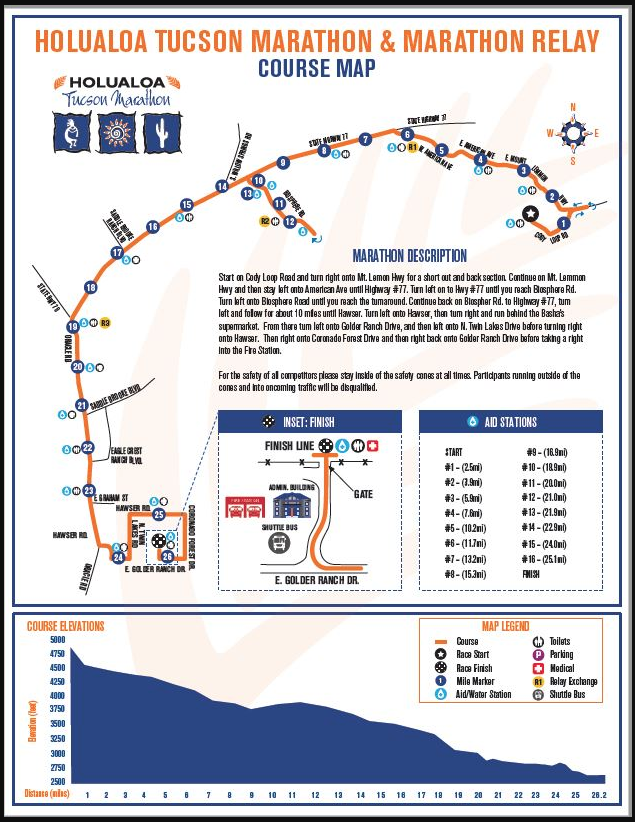
Graphic provided by official Tucson Marathon site.
The Tucson Marathon Course has a total ascent of 369.41 feet and has a maximum elevation of 4,810.66 feet. The course begins with racers running downhill. The first couple miles felt pretty effortless because of this downhill factor (and due to all the adrenalin coursing through my system.)
I had chosen a “very conservative start” option because I wanted to prevent burning through too much energy at the front end while my body warmed up–a mistake I have made in the past AND learned from!
Those first few miles are very telling. You can judge pretty early on how your race is going to go based on how you feel those first three miles. My body was feeling good, my heart rate was staying pretty steady so I was encouraged.
Early on in the race, Annie started having some problems keeping her heart rate down and just feeling good in general and encouraged me to go ahead; to stay on pace. We knew this was a possibility based on how she had been feeling, but I was still sad to not have her by my side.
She and I would reunite several times during the race for bouts together–she is SO strong and fast–but the majority of the race I ran alone. Well, not alone, there were several hundred others running as well, but no one I knew. 🙂
At the 10k timing strip, someone dropped a water cup in my path and I had to hurdle it not to trip over it. This hurdling maneuver just happened to launch me over the 10k pad that marks that you have crossed it when you land on it.
When I realized I hadn’t put my foot on it I started to panic. I knew that races were really cracking down on cheaters and that one way they are cracking down is making sure that the marathon participant has cleared all the mile check points. I considered turning around and running back, but luckily a sage woman running by me, eased my worries by saying that the chip in my bib would log that I had been there, not the track pad beneath my feet. That was good news!!
The Biosphere
One of the really cool landmarks of interest on the Tucson Marathon course is the Biosphere. “The Biosphere is an Earth system science research facility located in Oracle, Arizona, owned by the University of Arizona. It operates as a center for research, outreach, teaching, and lifelong learning about Earth, its living systems, and its place in the universe. It is a 3.14-acre structure originally built to be an artificial, materially closed ecological system, or vivarium. It remains the largest closed system ever created”[2]” (Wikipedia.org).
While this research facility is undoubtedly cool, the run up to the facility and back was not something I was looking forward to on this course. You leave the main highway and begin a 2.5 mile ascent to the Biosphere around mile 10. I knew the long climb would mess with my split averages because I was going to have to ascend about a minute-per mile slower (in some spots 2-minutes per mile slower) to not burn myself out this early in the race.
Racers that have summited this section pass you on the their way back down to the highway, so I took the opportunity to count how many women were in front of me. I counted 12. 12 women were in front of me about halfway through the race. I would see how many of them I could catch and pass over the next 13 miles.
I was SO happy when I reached the top, around mile 12, and started back down to the highway. The hardest part of the race was over. (Other than the hill at mile 24 that was coming up).
Once I hit mile 14, I knew I was in good shape for the next nine miles. This nine-mile stretch had a slight downhill grade to it. Perfect.
Miles 24 – Finish
I was feeling good at the end of the race, but did see a noticeable inability to keep my pace-band splits after mile 20. My goal to stay at a 7:20 per mile was easing into 7:35 or slower, but I just kept on moving as fast as I could. The uphill, rolling section of the last part of the course is not ideal. Most courses I have ran, except for NYC, mercifully descend on the last couple miles or are flat at least. Not Tucson.
My Strava Splits According to My Pace Watch

I kept my cadence average at 188 which was great, but something definitely started to slow me down there at the end. I need to figure that out.
Since we had driven the course the day before, when I reached the point where I knew I had one, 400 meter section, a right turn, another 200 meter section and then the finish line I started going into an all-out sprint.
I had stopped really paying attention to my pace band at this point since the last couple miles I was off pace. I was turning my legs over as quickly as I could for where I was in the race. I really had no idea what my time was other than I knew I was around my goal.
When I rounded the corner and could view the clock, I saw that if I kicked it up a notch, I would come in under 3:17. I didn’t know I had another level of speed to kick up to, but surprisingly found it and dashed across the finish line strong and happy. It felt great to grab that medal at the end.
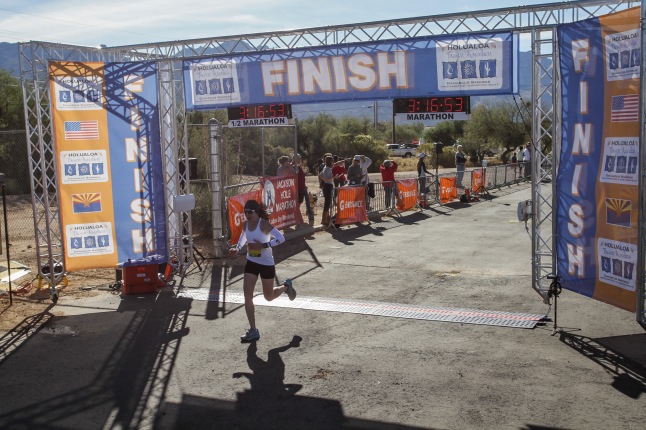
My Race Results
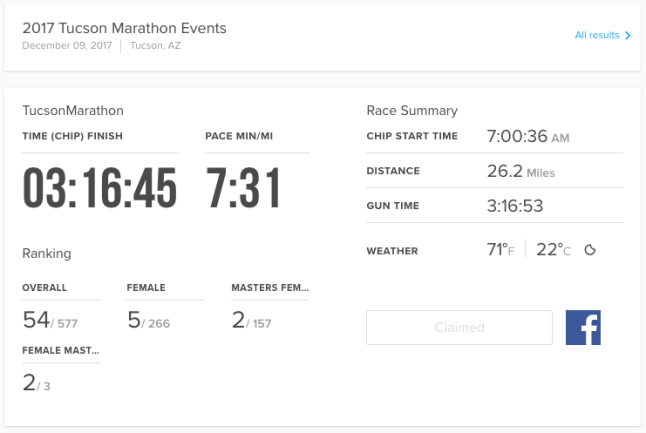

After crossing the finish line, my eyes quickly filled with tears–something that pretty much happens after every marathon. It is inexplicably emotional. There is such a release after 16-18 weeks of training, 3+ hours of running and plotting and then being done. What made that moment even sweeter was finishing strong and meeting my goal.
While it wasn’t my pace band projected time of 3:15, I was VERY happy with my 3:16:45. The course had been challenging, and I had had a great race. AND an added bonus was that I had not only qualified for the 2019 Boston Marathon, but also the NYC marathon (if I desired to run it again).
My finish time placed me as 5th woman overall. At some point I had managed to pass eight of the 12 women I had counted at the halfway mark. I also placed second in my age group so I received an award made by a local artisan:
Finish Line Fun
My first order of business after crossing the finish line was to get some recovery fluids into my system. I was quickly met by a young, eager volunteer who went and retrieved my gear bag for me! That was really nice. As mentioned earlier, I took my recovery drink –and a couple of Advil to head off the pending inflammation–and put on my warm clothes, discarding what I could into my race bag. My body temperature drops quickly after I stop running so I always put on extra layers after if they are readily available.
Once I had some recovery fluids in me, and my jacket on, I went back to the finish line to look for Annie. Given her struggle on the course, I didn’t think she had crossed yet, but was surprised (and NOT surprised) to see she had.
Despite her sickness and injuries she had still put down a 3:23:55!! Her PR is a 3:04 so she is obviously capable of faster times, but I was immensely impressed with what she accomplished in the face of real physical challenges. Rockstar.
After the Race
The Tucson Marathon also had a pretty impressive spread of recovery food options. Fruit, peanut butter, nutella, and pbj sandwiches, coconut water, fruit, etc. I only wished they had had chocolate milk; my stomach doesn’t really tolerate anything else post race.
I tried to put down a peanut butter and flatbread sandwich, but could only swallow one bite. My Latex Fruit Syndrome doesn’t allow me to have bananas so there wasn’t much for me, but Annie found several things she could recover with.
We claimed our age-group awards (she placed in hers as well) and we boarded the bus they provided back to our hotel.
A Couple Hours at the Spa
The race host hotel, the El Conquistador Resort by Hilton , really was top notch. We were (initially) a little annoyed that they didn’t have a late check-out option, which forced us to check out that morning before we boarded the buses. However, they gave us the option to use their spa for our post-race needs. The spa was perfect. We were able to shower and get cleaned up in a luxurious environment followed by some relaxation poolside.
Tucson Weather in Dec: Perfect for Winter Marathon
It was a little chilly at the start, but I found that I quickly warmed to a comfortable temperature. I chose to run in shorts, a singlet, arm sleeves, and a headband. I thought I would throw my arm sleeves to the side once I warmed up, but found I was comfortable with them through the entirety of the race. Race temperature after descending the first couple miles was around 50–which is perfect for racing. At the race conclusion, it was about 65. Not bad at all. Luckily, although some stronger winds had been predicted, the wind didn’t feel stronger than about 5 mph throughout the race.)
Marathon Strategy
I gauge my speed highly on what my heart is doing. I frequently look at my Garmin Vivoactive Heart Rate pace watch to make sure it isn’t climbing to quickly and to keep it out of the 170s. Ideal heart rate for me is low 160s when I’m racing a marathon. The last 5k, I let it creep into the 170s, but not earlier or I will hit the wall.
I use my pace band to have goal paces throughout, and check my mile-splits average to make sure I am on track for my goal-finish time.
Tucson was tricky because the course is much hillier than you would think with all that net downhill you end up with over the course. Having to slow down to keep my heart happy on the uphills meant I had to speed up on the downhills or flatter sections to stay on pace.
I always walk the water stops too. I’m trying to make those stops quicker, but if I try running through them, I end up spilling most of the water I am trying to drink out of my cup while I bounce around.
I don’t like to run with water so rely totally on the water stations on the course. I do carry my own gels though. Gu Roctanes are my go-to marathon gels. I take them at miles 5, 10, 15, 20 and sometimes 25; often I will just go for gatorade at mile 25 since I am so close to the finish.
Grateful
Despite all my pre-race anxiety for Tucson, I am extremely glad that I faced those fears and raced. The outcome and experience were immensely positive.
The freedom to move my body how I like, as fast as I like, as long as I like, etc., is a freedom that I don’t take for granted. Hopefully, if I train smart, it will be a freedom that I can enjoy for another 40+ years.
Next Up
2018 will have me experiencing some new courses and some old. I will return to Boston for the 4th consecutive year with my training pal and friend, Brooke Clayton. Annie is planning to be on the course as well!
The plan for that race is to treat it like a long training run, at about an 8-minute per mile pace. The reason for this being that two weeks after Boston, I am signed up for the REVEL Mt Charleston Marathon in Nevada. It is much closer to Boston than I would like, but I have been wanting to race this marathon for a while now and am not ready to eliminate Boston from my annual racing schedule.
Thanks for reading!



